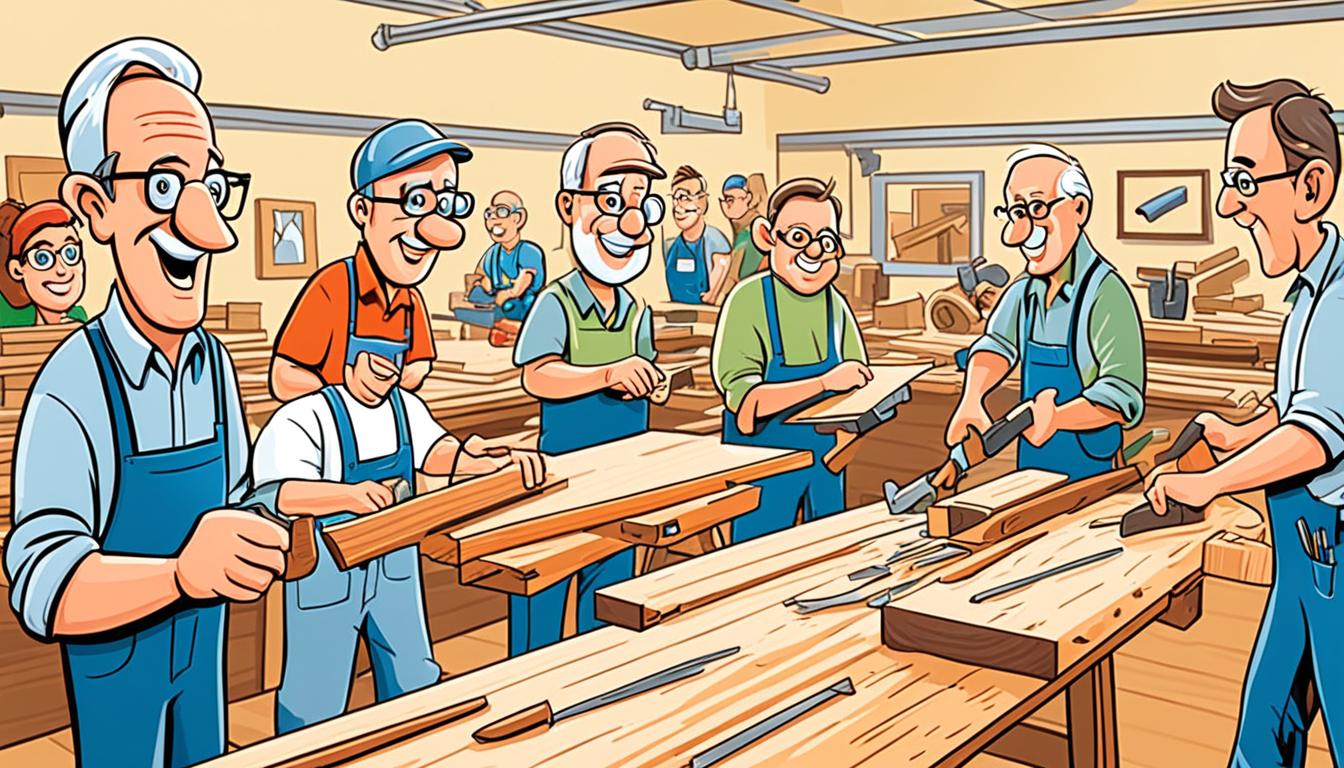woodwork formation beginners. Are you a beginner looking to dive into the world of woodwork formation? Or perhaps you’ve already started but feel overwhelmed by all the intricacies involved? Don’t worry, we’ve got you covered! In this comprehensive guide, we’ll walk you through everything you need to know to get started with woodworking basics. Get ready to unleash your inner craftsman and discover the joy of creating beautiful, functional objects with your own two hands.
Table of Contents
ToggleKey Takeaways:
- Understanding the basics of woodworking is crucial for beginners.
- Choosing the right tools and materials is essential for successful woodwork formation.
- Mastering woodworking techniques will allow you to create intricate and beautiful designs.
- Always prioritize safety and take necessary precautions in the woodshop.
- Planning your projects effectively will ensure smooth execution and satisfying resuEssential Woodworking Techniques for Beginners
woodwork formation beginners: Essential Woodworking Techniques for Beginners
In this section, we will explore 11 essential woodworking techniques that beginners should learn. These techniques are the building blocks of successful woodworking projects and will help beginners develop their skills and create impressive pieces.
Milling
Milling is the process of transforming rough lumber into precise blocks for woodworking projects. It involves using tools like the jointer, planer, and table saw to flatten the wood, make it smooth, and cut it to desired dimensions. Milling is a foundational technique that ensures your wood is properly prepared for further shaping and joinery.
Jointing and Planing
Jointing and planing are essential techniques used to achieve flat and smooth surfaces in woodworking. Jointing involves flattening one face and one edge of the wood, while planing is used to smooth and remove excess material from wooden surfaces. These techniques require specific tools, such as the jointer and planer, and are critical for creating properly prepared surfaces for assembly.
Sawing
Sawing is often the starting point of many woodworking projects. It involves cutting down wood using various types of saws, such as the chop saw, hand saw, or table saw. Learning different sawing techniques will help beginners make accurate cuts and achieve the desired dimensions for their projects.
Drilling and Boring
Drilling and boring are techniques used to create holes in wood. While drilling involves creating a hole, boring enlarges an existing hole. These techniques require the use of drill bits and a drill press or handheld drill driver. Mastering drilling and boring techniques is essential for adding functionality to your woodworking projects.
Routing
Routing is a versatile technique used to add decorative details to wood surfaces. It involves using a router, either handheld or mounted on a table, with various bits to create edge treatments, grooves, and follow patterns. Understanding routing techniques allows beginners to enhance their woodworking projects with beautiful and intricate designs.
Gluing and Clamping
Gluing and clamping are essential techniques for joining wood pieces together. Wood glue creates strong and durable bonds, while clamps hold the pieces in place until the glue sets. Beginners should learn about different types of glue and clamps to ensure successful wood joinery in their projects.
Shaping and Molding
Shaping and molding techniques are used to create non-rectangular shapes and add artistic elements to woodworking projects. These techniques involve carving, steam bending, scrollwork, lathe turning, veneering, and lamination. By mastering shaping and molding techniques, beginners can introduce unique designs to their woodworking projects.
Scrollwork
Scrollwork is a decorative technique that involves creating intricate and artistic designs using a scroll saw. By learning scrollwork techniques, beginners can add personalization and intricacy to their woodworking projects, such as creating beautiful fretwork or customized patterns.
Lathe Turning
Lathe turning is a technique used to shape wood by rotating it against a cutting tool. It allows beginners to create cylindrical shapes, decorative profiles, and even bowls. Mastering lathe turning techniques expands the possibilities for creating unique wooden objects.
Veneering and Lamination
Veneering and lamination techniques involve applying thin slices of wood (veneer) or laminating multiple layers of wood together to create visually appealing and structurally sound surfaces. These techniques are commonly used in furniture making and allow beginners to utilize different wood species for beautiful and durable projects.
Sanding and Filing
Sanding and filing are final finishing techniques used to achieve smooth surfaces and remove imperfections in woodworking projects. Sanding involves using sandpaper to smooth the wood, while filing is used to round down hard corners and edges. Learning proper sanding and filing techniques helps beginners create professional-looking finishes in their projects.
Understanding and mastering these essential woodworking techniques will provide beginners with a solid foundation for their woodworking journey. By practicing and applying these techniques, beginners can take on a variety of beginner woodworking projects, enjoying the process and gradually building their skills to tackle more complex and challenging tasks.
Milling: The Foundation of Woodworking
Milling is a crucial step in woodworking that serves as the foundation for creating precise and polished projects. This process involves transforming rough lumber into geometrically accurate blocks that are ready for joinery.
When it comes to milling, beginners must familiarize themselves with essential woodworking tools that facilitate this process. These tools include the jointer, planer, and table saw, which work in tandem to flatten the wood, smooth its surfaces, and cut it to the desired dimensions.
By utilizing a jointer, woodworkers can ensure that one face and one edge of the wood are perfectly flat and straight. This creates a sturdy and level base for subsequent woodworking steps. On the other hand, a planer is used to remove excess material and achieve consistent thickness throughout the wood.
The table saw, a versatile power tool, is employed to make precise cuts and create clean edges. It allows woodworkers to customize the dimensions of the lumber according to their project requirements.
The milling process prepares the wood for joinery, where pieces are connected to form the final structure of a woodworking project. By milling the lumber accurately, beginners can achieve tight and seamless joints, ensuring the stability and durability of their creations.
To illustrate the importance of milling, consider the analogy of a building’s foundation. Just as a sturdy foundation supports and ensures the integrity of a structure, proper milling sets the groundwork for successful woodworking projects.
Here’s an example table that outlines the tools involved in the milling process:
| Tool | Description |
|---|---|
| Jointer | A power tool used to flatten and straighten the faces and edges of wood. |
| Planer | A power tool used to achieve consistent thickness and smooth surfaces on the wood. |
| Table Saw | A versatile power tool used for making precise and customized cuts. |
Mastering the milling process and becoming proficient in the use of these tools will empower beginners to create high-quality woodworking projects with accuracy and precision.
Now that we’ve established the importance of milling in woodworking, let’s delve into the next section to explore the essential techniques of jointing and planing.

Jointing and Planing: Achieving Flat and Smooth Surfaces
When it comes to woodworking, achieving flat and smooth surfaces is crucial for creating high-quality projects. Two techniques that play a vital role in achieving this are jointing and planing. Let’s delve into these techniques and understand how beginner woodworkers can master them.
The Importance of Jointing
Jointing is the process of flattening one face and one edge of a wooden board. It’s a crucial step in the milling process, where rough lumber is transformed into precisely dimensioned blocks. Jointing not only creates a flat reference surface but also establishes a straight edge for subsequent operations.
To achieve a jointed surface, woodworking beginners need to utilize a jointer – a specialized tool designed for this purpose. The jointer features rotating blades that remove material from the wood’s surface, resulting in a flat and accurately squared edge.
By mastering the jointing technique, beginner woodworkers can ensure that their project materials have a solid foundation, enabling precise joinery and consistent results throughout their woodworking projects.
The Art of Planing
Planing is another essential technique that complements jointing and helps achieve smooth and refined surfaces. While jointing focuses on flattening one face and one edge of the wood, planing is primarily concerned with smoothing the remaining surfaces and removing any excess material.
To accomplish planing, beginner woodworkers need to utilize a planer – a versatile tool that removes material from the wood’s surface in a controlled and even manner. With the help of adjustable blades and a flat reference plate, the planer creates a consistently smooth surface across the wood.
Whether it’s removing mill marks or ensuring uniform thickness, proper planing can significantly enhance the overall appearance and quality of woodworking projects.
Mastering Jointing and Planing Techniques
While jointing and planing may seem daunting to beginners, with practice and guidance, these techniques can be mastered. To get started:
- Invest in a reliable jointer and planer that suit your woodworking needs.
- Ensure your tools are properly calibrated and maintained for optimal performance.
- Learn the correct technique for jointing and planing by studying online tutorials or seeking guidance from experienced woodworkers.
- Practice on scrap pieces of wood before working on your actual projects to refine your skills and gain confidence.
- Pay attention to safety precautions, such as wearing protective gear and using push blocks when operating the jointer and planer.
By incorporating jointing and planing into your woodworking routine, you’ll be able to achieve flat, smooth, and professional-looking surfaces that serve as a solid foundation for your projects.
With practice and patience, jointing and planing will become essential skills in your woodworking repertoire, allowing you to create beautifully crafted projects that showcase your talent and dedication. So, embrace these techniques, invest in the right tools, and unlock a world of possibilities in your woodworking journey!
Sawing: The Starting Point of Woodworking
Sawing is an essential skill that serves as the starting point for most woodworking projects. Whether you’re a beginner or an experienced woodworker, understanding different sawing techniques and using the right saw for the job is crucial for achieving accurate cuts and bringing your woodworking ideas to life.
When it comes to sawing, there are various types of saws to choose from, each designed for specific tasks and materials. Let’s explore some of the common saws used in woodworking:
- Chop Saw: Ideal for making precise crosscuts, the chop saw is commonly used for cutting stock to length.
- Hand Saw: A versatile tool for general woodworking tasks, the hand saw is perfect for cutting smaller pieces or making fine, controlled cuts.
- Portable Circular Saw: With its compact design, the portable circular saw is great for jobs that require mobility. It is excellent for cutting large boards or sheets of plywood.
- Table Saw: A staple in any woodworking shop, the table saw offers precise and straight cuts. It is commonly used for ripping boards and making accurate crosscuts.
- Chainsaw: Typically used for outdoor projects such as tree felling and log cutting, the chainsaw is a powerful tool for working with larger pieces of wood.
- Bandsaw: Known for its versatility, the bandsaw can make intricate curved cuts and is useful for resawing, where a board is cut into thinner pieces.
- Scroll Saw: Perfect for intricate cuts and delicate patterns, the scroll saw is commonly used in woodworking projects that require precision and detail.
Sawing Techniques: Tips for Beginners
For beginners, developing proper sawing techniques is essential for accurate and safe woodworking. Here are a few tips to get you started:
- Ensure your workpiece is securely clamped or held in place to prevent shifting or movement during sawing.
- Take your time and make a steady, controlled motion when guiding the saw through the cut.
- Let the saw do the work. Avoid applying excessive force, as it can lead to imprecise cuts and potential accidents.
- Always wear appropriate safety gear, including safety glasses and gloves, to protect yourself from any flying debris.
- Familiarize yourself with the specific saw you are using. Read the manufacturer’s instructions and practice proper handling and maintenance.
Remember, practice makes perfect when it comes to sawing. Start with small projects and gradually build your skills and confidence. As you gain experience, you’ll be able to tackle more challenging woodworking projects with precision and ease.
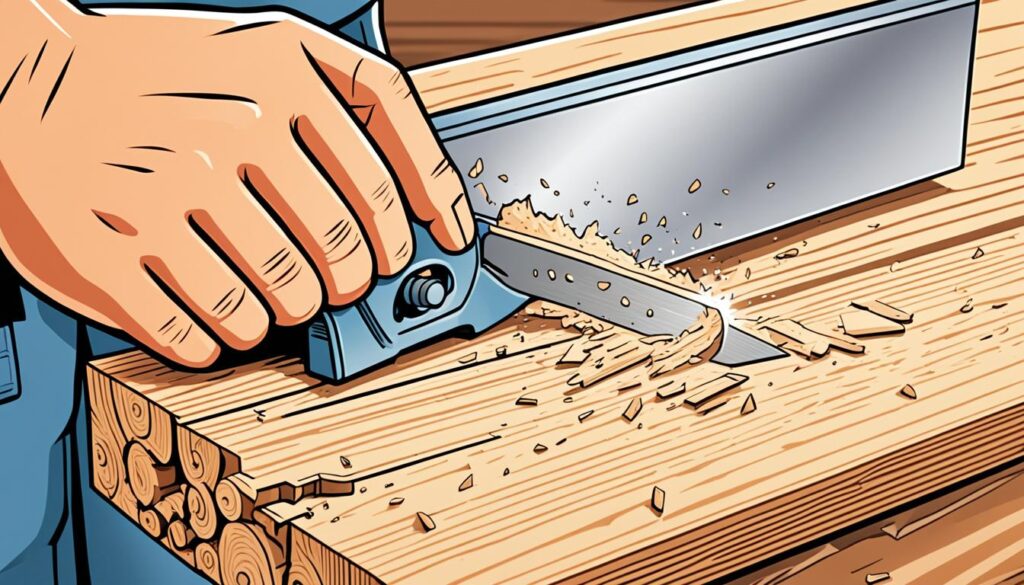
Drilling and Boring: Creating Holes in Wood
Drilling and boring are essential techniques used in woodworking to create holes in wood. Whether you need to insert screws, create openings for dowels, or add decorative elements to your projects, drilling and boring play a crucial role in achieving accurate and precise results.
Drilling involves the process of creating a hole in wood using a drill bit. Beginner woodworkers must learn how to select the right drill bit for their specific needs. Twist bits, forstner bits, and spade bits are some common types of drill bits used in woodworking.
To achieve accurate and clean holes, it is important to use the appropriate drilling tools. A drill press is a stationary machine that provides stability and control during the drilling process. It allows you to adjust the drilling depth and maintain consistent results. For handheld drilling, a drill driver is commonly used, offering flexibility and portability.
Boring, on the other hand, enlarges existing holes to accommodate larger fasteners or other components. Boring tools, such as adjustable boring bits or hole saws, are used to achieve this. These tools are designed to remove material in a circular motion, resulting in precise and clean holes.
As a beginner, it is crucial to understand the differences between drilling and boring techniques. Drilling creates new holes, while boring enlarges existing holes. By mastering these techniques, you will have the ability to create various types of holes, depending on your woodworking project requirements.
“Drilling and boring are fundamental techniques in woodworking that allow you to create holes of different sizes and shapes, expanding the possibilities of your projects.”
Woodworking Tips for Beginners: Drilling and Boring
Here are some useful tips to keep in mind when it comes to drilling and boring in woodworking:
- Choose the right drill bit: Selecting the appropriate drill bit for your project is essential. Consider factors such as the material you’re drilling into and the size of the hole you need to create. The right drill bit ensures clean and accurate results.
- Align and secure your workpiece: Before drilling or boring, make sure your workpiece is properly aligned and securely clamped in place. This prevents movement or shifting during the process, minimizing the risk of errors.
- Maintain a steady speed: When drilling, it’s important to maintain a consistent speed throughout the process. Too much speed can cause the bit to overheat or burn the wood, while too little speed can result in rough or jagged holes.
- Use proper safety precautions: Always wear protective gear, such as safety glasses, to shield your eyes from flying debris. Additionally, use clamps or a vice to secure your workpiece firmly, ensuring a stable work environment.
By following these tips and practicing drilling and boring techniques, you will gain confidence in creating precise holes for your woodworking projects.
Routing: Adding Decorative Details
Routing is a versatile technique that allows woodworkers to add beautiful and intricate decorative details to their projects. Whether you’re a beginner or an experienced woodworker, routing can elevate your woodworking projects to the next level.
Using a router, which can be handheld or mounted on a table, along with various router bits, you can create edge treatments, grooves, and follow patterns on wood surfaces. The router smoothly removes material, leaving behind clean and precise cuts.
Types of Router Bits
There are several types of router bits that you can use for different routing applications. Here are a few examples:
- Straight Bits: These bits are perfect for cutting straight lines and creating clean, smooth edges.
- Rabbeting Bits: Rabbeting bits are used to cut grooves and notches along the edge of a wood piece.
- Flush Trim Bits: Flush trim bits are ideal for trimming excess material and creating flush edges.
- Chamfer Bits: Chamfer bits create beveled edges on wood, adding a decorative touch.
These are just a few examples of the many router bits available. Each bit serves a specific purpose and can be used to achieve different decorative effects in woodworking projects.
Enhancing Beginner Woodworking Projects
“Routing can take your beginner woodworking projects from ordinary to extraordinary. With a combination of creativity and the right router bits, you can add unique and eye-catching details that will impress everyone who sees your work.” – Woodworking Expert
Whether you’re working on a simple picture frame, a jewelry box, or a small shelf, routing can add that special touch that sets your project apart. You can create intricate patterns, decorative edges, and custom designs that showcase your craftsmanship and attention to detail.
For example, you can use a roundover bit to give your edges a smooth and rounded profile, or a cove bit to create concave curves along the edges of your wood pieces. These small details can make a big difference in the overall appearance of your project.
By experimenting with different router bits and techniques, you can unlock endless possibilities for enhancing your beginner woodworking projects and adding your personal touch to each piece.
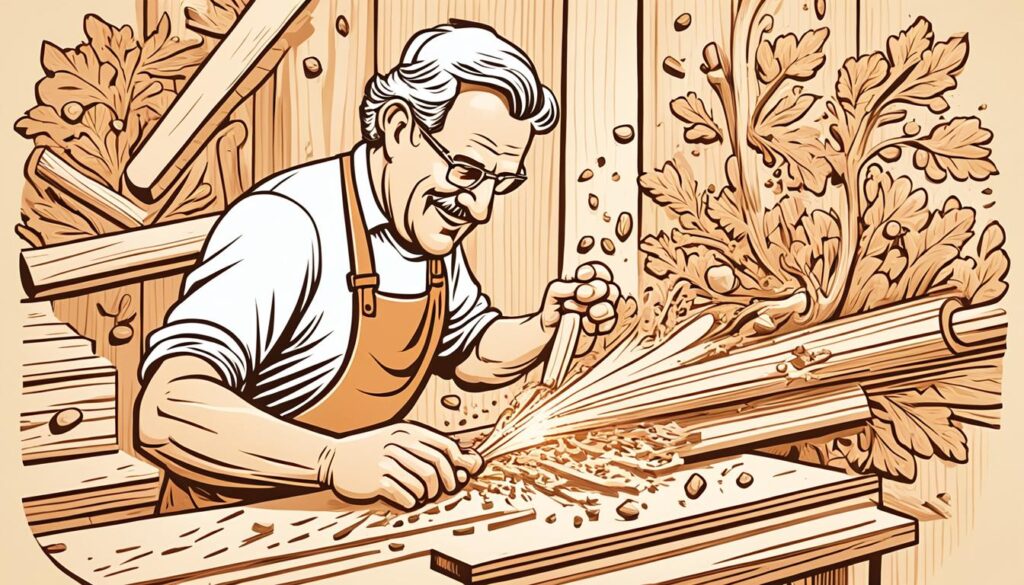
| Benefits of Routing in Woodworking | Examples of Decorative Routing Applications |
|---|---|
|
|
As a beginner woodworker, don’t be afraid to experiment with routing. Start with simple projects and gradually incorporate routing techniques into your work. With practice and patience, you’ll develop the skills and confidence to tackle more complex and elaborate routing designs.
Remember to prioritize safety when using a router. Always use the proper safety equipment, such as safety glasses and hearing protection, and follow manufacturer instructions for your specific router and bits.
Routing is a fantastic way to add decorative details to your beginner woodworking projects. Embrace the versatility of this technique and let your creativity shine as you transform ordinary wood pieces into stunning works of art.
Gluing and Clamping: Joining Wood Together
Gluing and clamping are essential techniques in woodworking. These techniques allow you to create strong and durable bonds between wood pieces, ensuring the longevity and stability of your projects.
When it comes to gluing, it’s important for beginner woodworkers to understand the different types of glue available. Some common options include white and yellow interior glue, exterior glue, and epoxy. Each type of glue has its own specific purpose and characteristics, so it’s crucial to choose the right one for your project.
To achieve a successful wood joinery, you also need a variety of clamps. Clamps hold the glued pieces together until the adhesive cures, ensuring a tight and secure bond. Different types of clamps are suitable for different woodworking applications. Some popular options include bar clamps, pipe clamps, F-clamps, and spring-loaded clamps.
“Gluing and clamping are like a dynamic duo in woodworking. The glue creates the bond, while the clamps bring it all together.”
It’s important to apply the glue evenly and sparingly to avoid excessive squeeze-out and messy joints. Be sure to follow the manufacturer’s instructions for optimal drying time and curing process.
Remember, gluing and clamping require patience and precision. Take the time to align your pieces properly before applying glue and securing them with clamps. This will result in a strong and seamless joint that will stand the test of time.
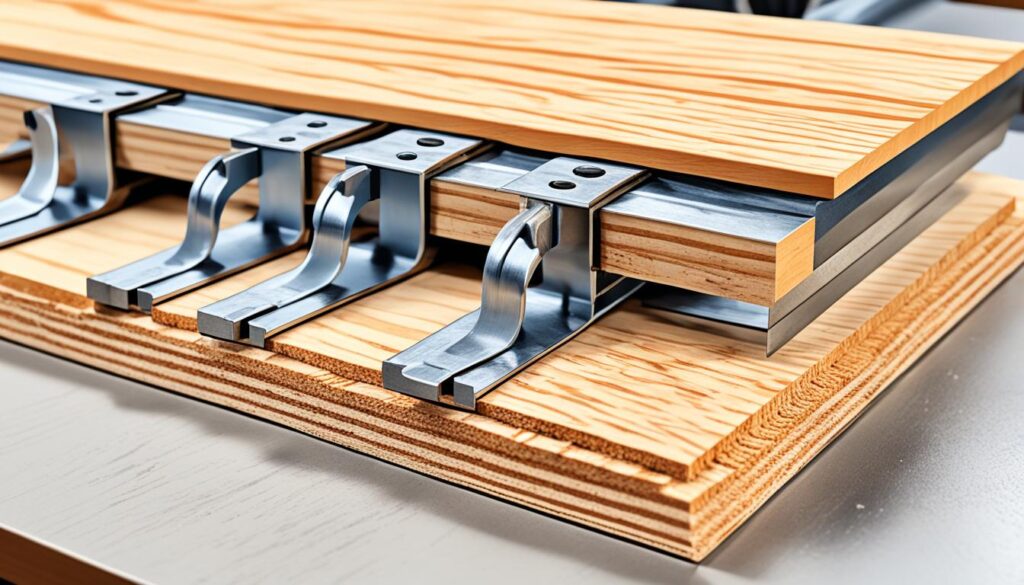
Example Table: Types of Glue and Their Uses
| Type of Glue | Main Characteristics | Best Used For |
|---|---|---|
| White Interior Glue | Quick-drying, water-based glue. Forms a strong bond on porous surfaces. | Indoor furniture, crafts, general woodworking projects. |
| Yellow Interior Glue | Slower drying time, better suited for complex assemblies. Provides a strong bond on both porous and non-porous surfaces. | Cabinetmaking, joinery, veneering. |
| Exterior Glue | Waterproof and weather-resistant glue. Offers excellent bond strength in outdoor applications. | Outdoor furniture, decking, garden structures. |
| Epoxy | Two-part adhesive that provides exceptional strength and durability. Can bond dissimilar materials. | Structural woodworking, marine applications, bonding metal or plastic with wood. |
Shaping and Molding: Creating Non-Rectangular Shapes
When it comes to woodworking, the possibilities are not limited to standard rectangular shapes. Shaping and molding techniques open up a world of creativity, allowing you to venture beyond the conventional and add unique elements to your projects. Whether you’re looking to create intricate curves, ornamental designs, or even custom skateboard shapes, mastering these techniques will elevate your woodworking skills to new heights.
One popular method for shaping and molding wood is carving. Carving involves using handheld tools like chisels and gouges to sculpt the wood into desired forms. This technique allows you to create intricate details and textures, giving your projects a distinct artistic touch. From decorative accents to functional embellishments, carving offers endless possibilities for expressing your creativity.
“Carving is like painting with wood. It allows you to bring your vision to life, adding a unique personality to your creations.”
– Sarah Johnson, Master Woodworker
Steam bending is another technique that enables you to shape wood into curved forms. By subjecting thin strips of wood to steam and carefully bending them around a form or mold, you can achieve graceful curves and flowing lines. This technique is commonly used in furniture making, boat building, and other woodworking projects that require elegant and ergonomic designs.
Scrollwork is yet another way to add decorative elements to your woodworking projects. Scrollsawing involves using a specialized saw with a small, thin blade to create intricate scroll-like patterns in wood. From delicate filigree to bold fretwork designs, scrollwork allows you to incorporate visually stunning details that instantly enhance the aesthetic appeal of your projects.
For those interested in creating rounded or cylindrical shapes, lathe turning is a technique worth exploring. Lathe turning involves securing a piece of wood to a spinning lathe and using sharp tools to shape and sculpt it as it spins. This technique is commonly used to make bowls, vases, table legs, and other cylindrical objects. With lathe turning, you can transform a plain piece of wood into a beautifully crafted and functional work of art.
Veneering and lamination techniques offer the opportunity to add striking visual appeal to your woodworking projects. Veneering involves applying thin layers of high-quality wood, called veneers, to the surfaces of less expensive or less visually appealing wood. This allows you to achieve the look of expensive or exotic wood species without the cost. Lamination, on the other hand, involves bonding multiple layers of wood together to create unique patterns and textures. Both techniques offer endless possibilities for creating eye-catching designs and captivating visual effects.
To provide you with a comprehensive understanding of shaping and molding techniques, here’s a helpful and visually engaging table summarizing their key aspects:
| Technique | Description | Applications |
|---|---|---|
| Carving | Sculpting wood with handheld tools | Decorative accents, functional embellishments |
| Steam Bending | Shaping wood using steam and molds | Furniture making, boat building |
| Scrollwork | Creating intricate patterns with a scrollsaw | Decorative elements, fretwork designs |
| Lathe Turning | Shaping wood on a spinning lathe | Bowls, vases, table legs, cylindrical objects |
| Veneering | Applying thin layers of wood to surfaces | Enhancing visual appeal, imitating expensive wood |
| Lamination | Bonding multiple layers of wood | Creative patterns, textures |
Exploring and mastering these shaping and molding techniques will not only add aesthetic value to your woodworking projects but also expand your creative horizons. Whether you’re a beginner woodworker looking to make your first custom piece or an experienced craftsman seeking to push the boundaries of your artistry, embracing these techniques will open doors to limitless possibilities.
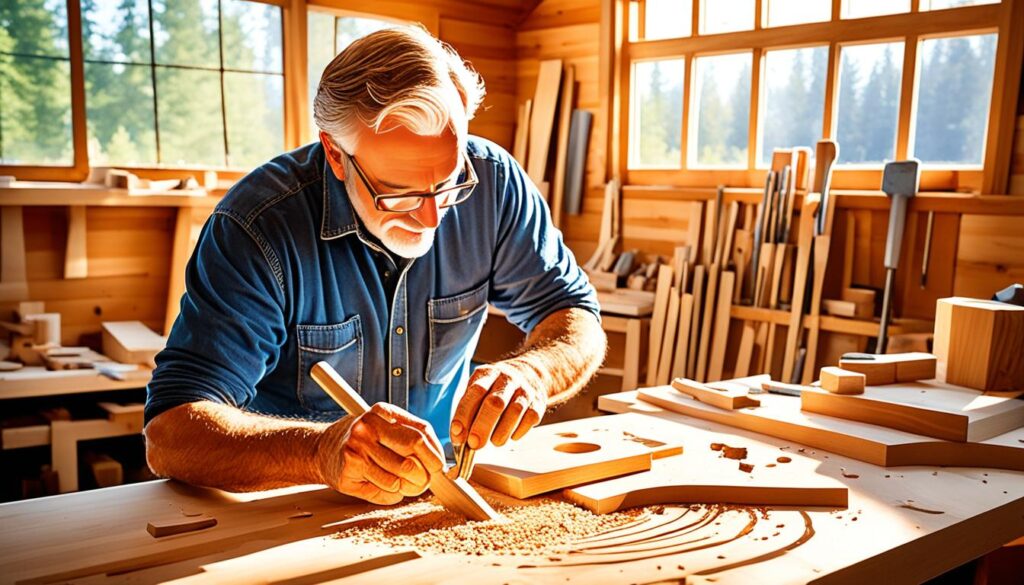
Sanding and Filing: Achieving Smooth Finishes
After putting in the effort to create a woodworking project, achieving a smooth and polished finish is the final step to bring out the true beauty of the wood. Sanding and filing techniques are essential for creating a flawless surface that is both visually appealing and tactilely satisfying.
Sanding is the process of using sandpaper to remove imperfections, such as rough edges, uneven surfaces, and minor blemishes. It helps in creating a smooth and uniform texture that enhances the overall look of the wood. For beginners, it’s important to understand the basics of sanding and choose the right sandpaper grits for the desired level of smoothness.
Start by selecting a coarse-grit sandpaper (around 80-100 grit) for initial sanding to remove any prominent imperfections. As you progress, gradually move to finer-grit sandpapers (such as 150, 220, and 320 grit) to achieve a smoother finish. Sand in the direction of the wood grain, applying even pressure and using long, fluid strokes. This will help avoid creating scratch marks and maintain the natural beauty of the wood.
Filing is a technique used to round down hard corners and edges, ensuring a safe and comfortable feel while handling the finished piece. Files come in different shapes and sizes, such as flat, round, or half-round, and can be selected based on the specific requirements of your project. By gently filing along the edges, you can create smooth, chamfered, or curved profiles, adding both aesthetics and functionality to your woodworking project.
When using sandpaper or a file, always work in a well-ventilated area and wear appropriate safety gear, such as goggles and a dust mask, to protect yourself from dust particles. Regularly check the progress of your sanding or filing by running your hand over the surface to ensure it feels smooth and free of imperfections.
Once the sanding and filing process is complete, you can proceed with applying your desired finish, such as varnish, stain, or paint, to protect the wood and enhance its natural beauty. Remember, patience and attention to detail are key when sanding and filing, as they contribute to achieving a professional-looking finish in your woodworking projects.
Sanding and Filing Tips for Beginners
| 1. Choose the right sandpaper grits for different stages of sanding. |
| 2. Sand in the direction of the wood grain for the best results. |
| 3. Use long, fluid strokes and apply even pressure while sanding. |
| 4. Start with coarse-grit sandpaper to remove prominent imperfections. |
| 5. Gradually progress to finer-grit sandpapers for a smoother finish. |
| 6. Wear appropriate safety gear, such as goggles and a dust mask, when sanding. |
| 7. File gently along the edges to round down hard corners and create smooth profiles. |
With proper sanding and filing techniques, beginners can transform their woodworking projects into stunning pieces of art that showcase their craftsmanship and love for the craft.
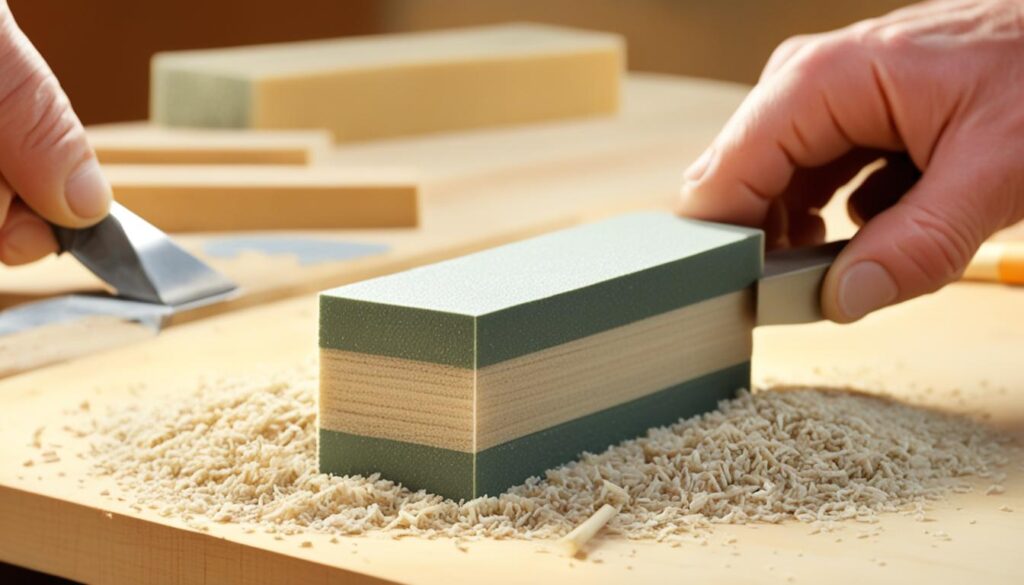
Safety First: Protecting Yourself in the Woodshop
Safety should always be the top priority when it comes to woodworking projects. As a beginner woodworker, it is crucial to understand and practice safety precautions to ensure a safe and enjoyable experience in the woodshop. By following these guidelines and developing good safety habits, you can protect yourself from potential hazards and create a secure working environment.
Wearing Protective Gear
One of the fundamental aspects of woodworking safety is wearing the appropriate protective gear. Make sure to equip yourself with safety glasses to shield your eyes from flying debris, especially when using power tools. Additionally, wearing hearing protectors can safeguard your ears from loud noise produced by machinery and power tools. It is also advisable to wear dust masks to protect your respiratory system from fine particles and dust generated during sanding or cutting wood.
Keeping the Workspace Clean and Uncluttered
A clean and organized workspace is essential for maintaining safety in the woodshop. Clear any clutter or obstacles that may cause accidents or impede your movement. Keep your work area tidy by promptly removing and storing tools, wood scraps, and other materials after use. This will minimize the risk of tripping or accidentally knocking over objects while working.
It is also crucial to have a designated storage area for all tools and equipment to ensure easy access and prevent them from being scattered around. Regularly sweep or vacuum the floor to eliminate sawdust, wood chips, and other debris that may create a slippery surface.
Using Tools and Equipment Properly
Proper usage of tools and equipment is vital for your safety in the woodshop. Before operating any machinery or power tools, carefully read and follow the manufacturer’s instructions. Familiarize yourself with the specific safety features and precautions associated with each tool or piece of equipment.
Always use tools for their intended purposes and avoid improvising or altering them in any way that may compromise safety. Maintaining tools in good working condition, such as keeping blades sharp and replacing worn parts, will enhance both their performance and your safety.
Being Aware of Potential Hazards
Being mindful of potential hazards in the woodshop is crucial for accident prevention. Some common hazards include kickbacks from power tools, contact with sharp cutting edges, and exposure to harmful fumes or chemicals. Take the time to understand the risks associated with each woodworking task and take appropriate precautions to mitigate them.
Ensure adequate lighting in the workspace to enhance visibility and minimize the chances of accidents. If working with power tools, use clamps or other forms of secure support to stabilize the material being cut or shaped. Avoid wearing loose-fitting clothing or accessories that may get caught in machinery.
Work at a comfortable pace, allowing yourself enough time to think through each step and make precise and controlled movements. Rushing or working under pressure increases the likelihood of accidents.
Remember, safety is a continuous process, and it is essential to stay updated on safety practices by regularly attending woodworking safety courses or workshops.
Building a solid foundation of safety knowledge and habits will ensure a safe and enjoyable woodworking experience. By taking every precaution and prioritizing your well-being, you can focus on honing your beginner carpentry skills and creating beautiful woodwork projects.
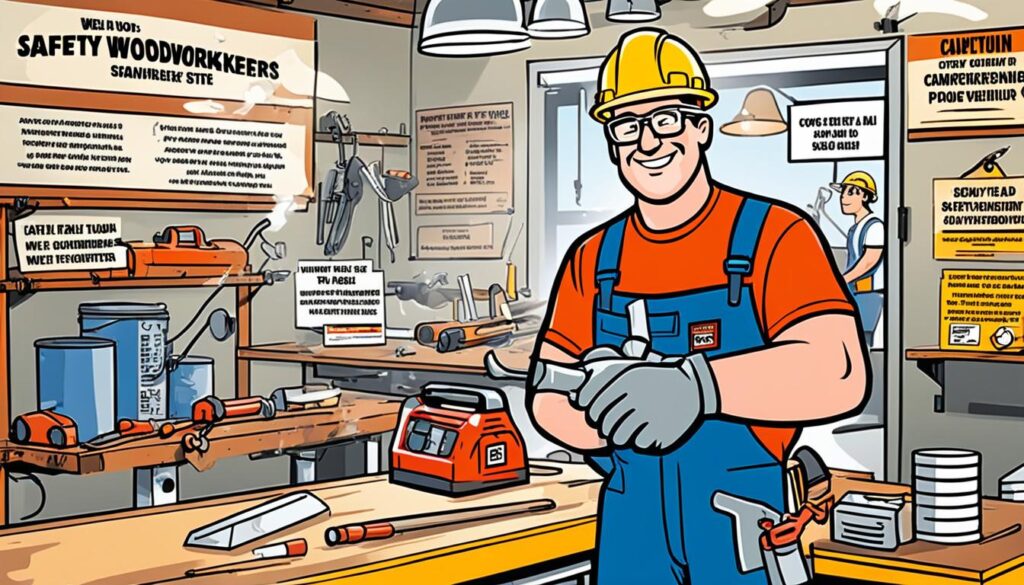
Tips for Choosing Wood and Planning Projects
Choosing the right wood for your projects and planning them effectively is crucial for successful woodworking. As a beginner in woodworking, it’s essential to understand the basics of selecting the appropriate wood species, considering factors like grain patterns, stability, and availability.
Selecting the Appropriate Wood Species
When starting woodworking as a beginner, it’s important to familiarize yourself with different wood species and their characteristics. Each species has unique properties that affect its performance and appearance in woodworking projects. Consider factors such as hardness, durability, and grain pattern to determine which wood species best suits your intended use. Some popular wood species for beginners include:
- Softwoods like pine, spruce, and cedar, which are readily available and relatively affordable.
- Hardwoods like oak, maple, and cherry, which are known for their durability and attractive grain patterns.
- Plywood and MDF (Medium-Density Fiberboard) are also commonly used in woodworking projects due to their stability and affordability.
Understanding Wood Dimensions
Wood dimensions play a crucial role in project planning. Common wood dimensions include thickness, width, and length. Understanding these dimensions will help you determine the amount of wood you need for your project and plan accordingly. Wood is typically sold in standard sizes, such as 1×4 or 2×6, indicating the rough dimensions of the wood before it is planed and sanded.
Effective Project Planning
Effective project planning is essential for a smooth woodworking experience. Here are some tips to help you plan your projects effectively:
- Create working drawings: Sketch out your project on paper or use design software to create detailed drawings. This will help you visualize the final result and plan the necessary steps.
- Make joint decisions: Discuss your project ideas and plans with fellow woodworkers, friends, or family members who have experience in woodworking. Their input and suggestions can improve your project’s design and functionality.
- Assess skill level and personal preferences: Consider your skill level and the tools at your disposal when selecting a project. Start with smaller, simpler projects that align with your current abilities and gradually move towards more complex ones as you gain experience.
By choosing the right wood and effectively planning your projects, you can set yourself up for woodworking success. Remember to start with smaller projects, practice your techniques, and have fun along the way!
| Wood Species | Characteristics |
|---|---|
| Pine | Softwood, knots, affordable |
| Oak | Hardwood, strong, attractive grain |
| Maple | Hardwood, durable, light color |
| Cherry | Hardwood, beautiful grain, reddish-brown color |

Effective project planning is the key to a successful woodworking journey. Take the time to choose the right wood species, understand wood dimensions, and plan your projects meticulously. By doing so, you’ll enjoy a more rewarding and satisfying woodworking experience.
Conclusion
Congratulations! You have completed the beginner’s guide to woodworking for newbies. Through the tips and techniques provided, you now possess the essential knowledge and skills to embark on your woodworking journey. It is important to always prioritize safety in your projects, ensuring you have the right beginner woodworking tools and practicing proper techniques.
Remember, woodworking is not just a hobby but a rewarding experience that allows you to create beautiful and functional objects with your own hands. Take the time to practice and refine your woodworking skills, and don’t be afraid to make mistakes and learn from them. The more you experiment and explore, the better you will become.
So, grab your beginner woodworking tools, select your favorite wood, and let your creativity flow. Whether you’re building furniture, carving intricate designs, or crafting small projects, enjoy the journey of woodworking. Happy woodworking!
FAQ
What is milling in woodworking?
Milling is the process of transforming rough lumber into geometrically precise blocks. It involves using tools like the jointer, planer, and table saw to flatten the wood, make it smooth, and cut it to desired dimensions.
What are jointing and planing?
Jointing involves flattening one face and one edge of the wood, while planing is used to smooth and remove excess material from wooden surfaces.
What are the essential woodworking tools for beginners?
Essential woodworking tools for beginners include the jointer, planer, table saw, chop saw, hand saw, portable circular saw, drill press, drill driver, router, clamps, and sanders.
What are the different types of saws used in woodworking?
Different types of saws used in woodworking include the chop saw, hand saw, portable circular saw, table saw, chainsaw, bandsaw, and scroll saw.
What are the techniques used to create holes in wood?
The techniques used to create holes in wood are drilling and boring. Drilling creates a hole, while boring enlarges an existing hole.
What is routing in woodworking?
Routing is a versatile technique used to add decorative details to wood surfaces. It involves using a router, either handheld or mounted on a table, with various bits to create edge treatments, grooves, and follow patterns.
What are the different types of glue used in woodworking?
Different types of glue used in woodworking include white and yellow interior glue, exterior glue, and epoxy.
What are the techniques used to shape and mold wood?
The techniques used to shape and mold wood include carving, steam bending, scrollwork, lathe turning, veneering, and lamination.
What are the final steps in achieving smooth finishes in woodworking projects?
The final steps in achieving smooth finishes in woodworking projects are sanding and filing. Sanding involves using sandpaper to remove small imperfections and create a smooth surface, while filing is used to round down hard corners and edges.
What are some safety precautions to follow in woodworking?
Safety precautions in woodworking include wearing protective gear like safety glasses, hearing protectors, and dust masks, keeping the workspace clean and uncluttered, using tools and equipment properly, and being aware of potential hazards.
How should beginners choose wood and plan their projects?
Beginners should learn how to select the appropriate wood species, understand wood dimensions, and consider factors like grain patterns, stability, and availability. Effective project planning involves creating working drawings, making joint decisions, and deciding what to build based on skill level and personal preferences.

